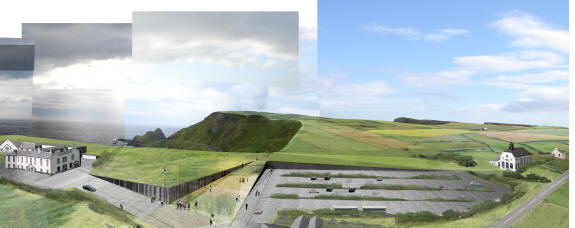| As Roofing Manager
for Dow Building Solutions – manufacturer of STYROFOAM™ thermal insulation –
I know a roof may be only 2% of the overall budget of a build. However, I
also know that in terms of the usability, longevity and performance of a
structure, a roof’s value far outweighs its cost, meaning it’s vital that
the right decisions are made when it comes to system design, material choice
and installation. |
 |
| With much of our
product going into large scale inverted flat roofing projects I spend a lot
of time on the roofs of schools, retail outlets and commercial office space
discussing delivery, installation and design challenges – but in recent
months long term performance and drainage issues have been dominating my
conversations as teams tackle decisions about thermal insulation choice for
inverted roofs. |
| Of
course considerations such as thermal efficiency requirements, product
availability, ease of installation and cost come first. However, besides
these requirements, there are two key things to remember when it comes to
specifying insulation for inverted flat roofs, and too often I see them
being considered at too late a stage: |
- Has the roof been designed with an
inverted roof solution in mind?
- Have all the relevant correction factors
necessary for a U-value calculation been taken into account?
|
| With
every client counting the cost of fuel – and so much importance being placed
on meeting energy standards and aiming for energy saving – it’s key that
such issues are taken into account in helping to allow an inverted roof
system to perform against required demands. |
|
Ensuring adequate drainage |
| Our
position at Dow is in line with BS 6229:2003: that an appropriate fall be
accommodated within the roof design and that the roof must be adequately
drained to prevent ponding. The location, size and number of rainwater
outlets should be designed in accordance with BS EN 12056-3:2000 and the
deck should be without deflections or depressions in which water may pond.
Drainage points should provide drainage at two levels: above the insulation
and at roof deck waterproofing levels. |
| We all
know that for cost reasons, ‘zero-pitch’ roofs are not uncommon. BBA
Information Bulletin No 4 advises that in such cases it is particularly
important to identify correct locations for drainage points and to ensure
that the drainage provided is sufficient and adequate. However, it is clear
that ANY roof should not have areas of ponding as a result of back falls -
and because insulation must not be permanently immersed or submerged in
water, they should be removed before insulation is installed. |
|
Various solutions are available which help to design out deflections without
resorting to the additional cost of laying additional screed – but such
design issues should be adequately tackled at an early stage and not left
until after the roof waterproofing has been chosen and installed. |
|
Thermal resistance |
|
European Technical Approval Guideline (ETAG) 031-1 – which sets out
performance requirements for inverted roof insulation kits – advises that
the declared thermal conductivity for insulation should be corrected due to
the special nature of the inverted roof application and the fact insulation
is being used in exposed rooftop conditions. |
| ETAG
031-1 states that possible water absorption over time is determined by
evaluating the performance of the insulation in respect of two mechanisms
for water absorption: by diffusion and post freeze/thaw. Corrected thermal
values are determined by assessing the total water absorption potential –
and it is these corrected values which ETAG 031-1 advises should be used in
any U-value calculations for inverted roof systems. |
|
ROOFMATETMSL-A, the STYROFOAM extruded polystyrene product we offer for
inverted roofs, has a closed cell structure which results in low water
pick-up over time, despite the rigorous conditions on exposed rooftops. For
example, tests shows that even after 300 cycles of freezing and thawing,
STYROFOAM will absorb less than 1% moisture by volume, one of the reasons it
continues to be specified for inverted roofs and other applications*. |
|
Rainwater cooling |
|
Rainwater able to reach the waterproofing layer on an inverted roof will
absorb heat from the underlying structure and affect the thermal performance
of a roof system. Therefore, the initial U-value of a roof system must also
be corrected by adding a rainwater correction factor according to Section 7
and Annex D.4 of BS EN ISO 6946:2007. |
| The
corrected U-value of an inverted roof will be dependent on the amount of
rainfall falling on the roof - which means it will be location specific -
and the proportion of rainwater which can reach the waterproof layer. |
| Dow
Building Solutions offers a water-flow reducing layer, ROOFMATE MK, which
reduces the proportion of rainwater reaching the waterproofing. Using
ROOFMATE MK in combination with ROOFMATE SL-A helps to minimise heat loss
due to rainwater cooling and therefore the amount of insulation required. |

picture courtesy of heneghan.peng.architects |
| Taking
a holistic view |
|
STYROFOAM products are CE-marked, meaning specifiers, installers and
end-users can rely on the fact that declared lambda values are made in
accordance with BS EN 13164:2008 and BBA datasheet No 40/10. Additionally,
recent improvements to thermal conductivity of STYROFOAM-A across the
product range of 0.002 W/mK - combined with the material’s high compressive
strength and excellent moisture resistance – will no doubt continue to make
ROOFMATE a popular choice in inverted roofing. |
|
However, we know that statements about product performance alone are not
enough: decisions about inverted roof insulation choices need to take into
account lifetime performance in real conditions on a real roof, not just the
laboratory or factory – that’s where the true test begins. |
|
STYROFOAM products have been used for inverted roofs in the UK since the
1960s and well before that in North America. Specifiers and roofing
contractors can not only rely on that longstanding industry performance when
making decisions about insulation materials but helpful advice from our
technical desk when making appropriate U-value calculations which take
relevant factors into account: making it easier for everyone to get it right
from the start. |
| For
technical support or help calculating a U-value contact our Technical
Services Team on
fkltech@dow.com. Literature and a stockist list can be found at
www.styrofoam.co.uk.
|
| |
| |